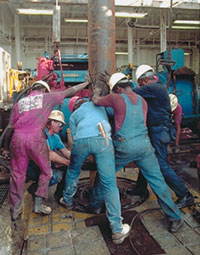South America: Trinidad and Tobago
Aug. 2001 Vol. 222 No. 8 International Outlook SOUTH AMERICA Stuart Wilkinson, Contributing Editor Trinidad And Tobago The country has enjoyed seven years
SOUTH AMERICAStuart Wilkinson, Contributing Editor Trinidad And TobagoThe country has enjoyed seven years of stable growth, increases in employment and low inflation. T&T is quickly becoming a key LNG supplier to the Western Hemisphere, and it will likely play an important role in meeting future U.S. gas demand. Exploration. The licensing round for seven offshore exploration blocks will conclude in September. Three blocks are previously unsold shallow-water acreage on the continental shelf to the east and southeast of Trinidad. Four of the blocks are located in under-explored deep waters to the east and northeast of Tobago. The government intends to launch an ultra-deep round before year-end. The shelf acreage includes a minor gas field named Carambola. Another block offered is Lower Reversal L, which is south of the established gas fields Keskidee and Pelican, and was relinquished by Enron last year. Another block (3a) is located east of BHP’s Angostura discovery. Partners ExxonMobil and Shell drilled three exploration wells on deepwater Blocks 25a, 25b and 26. None were successful. Shell is looking to farm out a 25% stake before drilling a second well on Block 26. Last September, BP announced the largest gas discovery to date offshore T&T. The discovery well on Red Mango field indicated possible reserves of 3 Tcfg and 90 million bbl of condensate. In May 2001, BP discovered another 1 Tcf of gas with its Cashima 1 well, about 2.5 miles east of Flamboyant field. The well was drilled in 263 ft of water to a 13,120-ft TD. Thus far, according to the company, BP’s T&T gas-exploration success rate has been 90%. BP will also drill two exploration wells on the shelf and one in deepwater Block 27. Drilling / development. Wells drilled were 43% higher, at 130. Although total footage was up 5%, footage drilled offshore was down 20%. The Energy Ministry forecasts a 10.7% increase this year, to 144 wells. To exploit BP’s new reserves, the company will invest $600 million in its offshore Kapok project. The work will require pipelines, an unmanned platform and a central processing facility capable of handling 1.6 Bcfgd, plus substantial liquids. Repsol-YPF agreed to acquire 10% of BP’s production assets in the country, with an option to acquire a further 20% within three years. Energy Minister Finbar Gangar said BP’s new gas discoveries justified the government’s decision to permit the addition of two new trains at the Atlantic LNG plant in Point Fortin. "The first land rig in 20 years" is how Upstream characterized New Horizon Exploration’s introduction of a unit to drill 18 vertical and three horizontal wells on Block E (Parryland oil field). The field’s 60-million-bbl reserves will require a $35-million investment for exploitation.
Production. National crude and condensate production declined again last year, averaging 130,867 bpd, 4.9% less than in 1999. However, the government reported that proved oil reserves increased 4.4%, to 716 million bbl in the same period. Gas production shot up 16.9%, to 1.5 Bcfd from 1999’s
level, while gas reserves rose 9.8%, to 23.5 Tcf.
|



